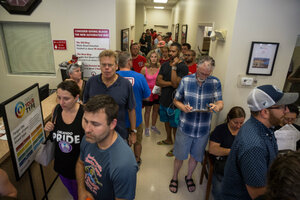Lessons after Orlando? Why South Africa ended ban on gay blood donors
Calls are rising after the Pulse gay nightclub shootings to end the US ban on blood donations by gay men. South Africa, as a high HIV-positive population, offers another model.

Donors line up inside OneBlood Blood Donation Center in Orlando, Fla., on Sunday, June 12. The center was flooded with donors after a mass shooting early Sunday morning at a gay nightclub, Pulse, in Orlando.
Loren Elliott/Tampa Bay Times/AP
Johannesburg, South Africa
For many here, it hardly registered on the Richter scale of human rights victories. But when the South African National Blood Service announced in May 2014 that it was lifting its ban on gay men donating blood, many LGBT activists here quietly celebrated. The ban, they argued, had been less about public health than social norms, and eliminating it would be significant both practically and symbolically to gay communities.
“We were taken to task so many times by [LGBT] organizations because they said there was nothing warranting the ban,” says Vanessa Raju, a spokeswoman for the SANBS. “And when we started looking at the statistics, it really made no sense.”
Now, with renewed calls to bring an end to a similar ban in the United States in the wake of the Orlando nightclub shooting, examples like South Africa’s may prove instructive, offering guideposts for alternative ways to balance safety and stigma in the collection of public blood donations.
“We felt it was important to recognize that it’s not about a person’s sexual orientation, it’s about their behavior,” says Johan Meyer, health manager at OUT, an LGBT health charity in Pretoria. “There have always been a number of gay people in this country who wanted to give back and donate blood and couldn’t for any other reason than their sexuality. Changing this regulation changed that.”
Similarly, in the days following the Orlando shooting last week, queues hundreds deep snaked through parking lots and neighborhoods in front of the city’s blood banks, filled by concerned Floridians with a simple goal – to help in any small way they could.
But one group close to the tragedy was conspicuously absent.
“There were so many gay victims involved with the attack, and so many of their loved ones were moved to step up and help their fellow Americans – but were unable to,” said Rep. Jared Polis (D) of Colorado outside the House of Representatives Tuesday, referencing a Food and Drug Administration ban that bars sexually active gay men from donating blood, a legacy of the period when HIV/AIDS was predominantly associated with the gay male population. “All of the pretenses of this policy are gone.”
For many years, South Africa – and many other countries – had a similar ban in place, designed to help keep HIV out of its public blood supplies at a time when viral testing technologies were in their infancy and the disease was often passed on via blood transfusion. Maintaining a safe blood supply has long been an especially monumental task here, in a country where more than 11 percent of the population is HIV-positive.
But over time, Ms. Raju says, South African health authorities began to realize – with the help of some prodding activists – that keeping such a ban was increasingly out of step with their own reality. After all, prohibitions on blood donations by homosexual men – or “men who have sex with men” in the public health parlance – harked back to an era when HIV was seen as a largely Western, white, and homosexual disease. In South Africa, however, the disease had a very different face – its most common victims were straight, black, and female.
“I think the lesson our example shows to the world is that you have to look at the risk factors in your own environment – it can’t be a cut and paste of another country’s policy,” she says. “We had done that.” And so the ban was quietly rolled back. In 2006, gay men were allowed to donate if they had been celibate for six months or longer, and in 2014, the prohibition was lifted altogether.
Like many countries, South Africa now screens potential donors – regardless of sexual orientation – by whether they have a “safe sexual lifestyle” – defined as long-term monogamy or celibacy. And testing of blood itself is abundantly cautious – blood from first time donors, for instance, is almost never used until they return for a second blood donation and receive a clean bill of health for a second time. These two factors, combined with a completely voluntary donor network, mean that South Africa’s blood supply is remarkably safe for a country with such a high disease burden, Raju says.
For many gay South Africans, however, the change has been a complicated one to make sense of. Having gay men classified as lower risk for HIV, while beneficial for allowing them to donate blood, might make it more difficult for activists and health workers to campaign as effectively for access to HIV treatment and prevention for those groups, says Gabriel Khan, the sexual diversity rights program officer at Hivos, a Dutch human rights organization, in Johannesburg.
For others, the conflict is more personal – why, some have asked, would I give blood to an organization that previously discriminated against me because of my sexual orientation?
Karabo Maloka, who works at a Johannesburg software company, wrestled for a time with that feeling. Now, however, he says he is grateful he can participate in the process.
“When everything happened in Orlando and there were so many people in the hospital, my friends I were talking about how terrifying it would be if anything like that happened here and people you loved needed blood,” he says. “It really just reignited for us that we should go out and donate as often as we can.”

